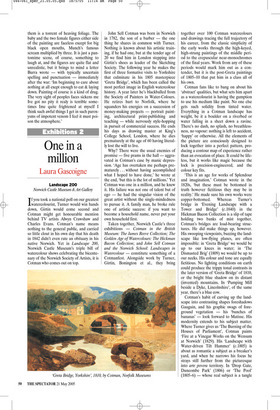Potent venom
John Spurling
Edward Burra 1905–1976 Lefevre Gallery, 31 Bruton Street, London W1, until 17 June
‘Everything looks menacing,’ Edward Burra once told the Tate’s director Sir John Rothenstein. ‘I’m always expecting something calamitous to happen.’ This was late in Burra’s career, when his by then well-known and characteristic figure paintings had mostly given way to landscapes and still lifes, though without any diminution in their imaginative power or their peculiar sense of humorous unease. There were still figures in some of them, though they had become more insubstantial. ‘Why,’ asked his friend William Chappell, ‘are you painting transparent people?’ ‘Well,’ said Burra, ‘don’t you find as you get older, you start seeing through everything?’ Like so many of the best British artists, Burra was sui generis, an eccentric who forged his inimitable style from a seemingly random bundle of influences. Signorelli gave his figures their tight bottoms and taut poses, Goya, Grosz and Breughel their malevolent, gross, oafish faces, Beardsley their febrile exhibitionism, De Chirico and Ernst their nightmarish settings and, occasionally, bird heads. And all, ladies and gentlemen, executed in watercolour! Afflicted from boyhood with arthritis and anaemia, Burra lived most of his life with his parents near Rye (which he called Tinkerbell Town) and after their deaths in one of the cottages in the grounds of their former home. He had to sit down to work and found oil painting beyond his strength. But his macabre imagination and passion for bold coloureffects demanded more than the atmospheric washes usually associated with watercolour, so he piled on layers of colour and forced the medium to dance to his more aggressive tune.
In spite of his physical weakness, he travelled extensively in Europe and America and, although he never attended his own private views, not even when the Tate gave him a retrospective in 1973 claiming that he knew the pictures perfectly well already and never showing any further interest in a painting he had finished — he frequently visited museums and other artists’ exhibitions. His visual memory was prodigious and what he observed, whether of life in bars and nightclubs and on the streets or of art on gallery walls, he could make use of afterwards, without even sketches to remind him, back at home, to stimulate, objectify and people his lusciously seedy imagination.
In this centenary exhibition at the Lefevre — now an almost secret gallery identified only by a brass plate beside the front door — where he showed regularly from 1952 until his death in 1976, there is a fine selection of paintings from the late 1920s to the early 1970s. The raffish, bubble world of Anthony Powell’s first novel Afternoon Men, as in Burra’s ‘Marriage à la Mode’, leads, by way of the idly thuggish streets of Harlem, to the statuesque violence of the Spanish Civil War depicted in ‘War in the Sun’, its colours warm, but its content — barred windows, stone walls, a tank, a piece of artillery pointed down the street, carapaced figures — hard and heart-sinking as a Piranesian prison. After the second world war, when even Burra’s sour vision of human brutality had been surpassed by reality, he turned to the rolling British landscape with its burden of thundering lorries and industrial development or, as in ‘Snowdonia’ in this exhibition, with cloud-like blue monsters lunging over the hills.
But perhaps Burra’s unique combination of savagery, satire, teasing political incorrectness, mastery of spacing and distortion, and exuberant colour is best demonstrated in the late work called ‘Punch Hitting Topsy Over the Head with a Baby’. All in bright yellow, his ogreish multicoloured face grinning sadistically, Punch swings his baby — also dressed in yellow — over his head, while sweet, black-faced Topsy in a blue striped frock flinches away. Behind them is a torrent of heaving foliage. The baby and the two female figures either side of the painting are faceless except for big black open mouths, Munch’s famous scream multiplied by three. It is just a pantomime scene, of course, something to laugh at, and the figures are quite flat and unrealistic, but it brings to mind a letter Burra wrote — with typically uncertain spelling and punctuation — immediately after the war: ‘Im beginning to care about nothing at all exept enough to eat & laying down. Painting of course is a kind of drug. The very sight of peoples faces sickens me Ive got no pity it realy is terrible sometimes Ime quite frightened at myself I think such awful things I get in such paroxysms of impotent venom I feel it must poison the atmosphere.’


























































 Previous page
Previous page